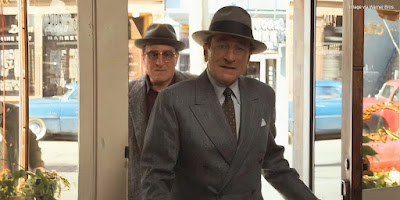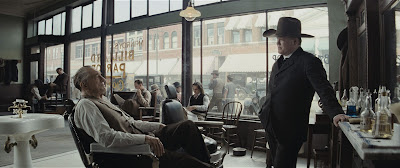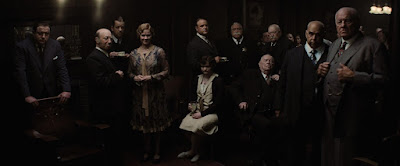Wednesday, April 16, 2025
The Alto Knights
Tuesday, December 24, 2024
Everybody's Fine

* That's another thing: there's no way De Niro could have had these three kids without marrying three different wives. Nobody looks like they belong in the same family. It looked good on paper on the Miramax ledger-sheet, I'm sure, but it looks like sham on the screen.
Thursday, August 1, 2024
What Just Happened
 What Just Happened (Barry Levinson, 2008) Ben (Robert De Niro) is a producer in Hollywood and he has a tough life. His new movie starring Sean Penn just previewed and the audience reaction cards don't look good. The director, wanting to be "edgy," has a scene where the bad guys shoot Penn's dog, then kill Penn. Audiences are upset about the dog. The studio (run by Catherine Keener) is upset about the audiences and wants to re-cut the film, the director is upset about his "vision" being changed and refuses to cooperate. Ben wants the to keep the director happy, the studio happy, the audiences happy, the two ex-wives (including Robin Wright) and three ex-children (including Kristen Stewart) happy, while still worrying about where he's standing in a Vanity Fair "Power in Hollywood" photoshoot.
What Just Happened (Barry Levinson, 2008) Ben (Robert De Niro) is a producer in Hollywood and he has a tough life. His new movie starring Sean Penn just previewed and the audience reaction cards don't look good. The director, wanting to be "edgy," has a scene where the bad guys shoot Penn's dog, then kill Penn. Audiences are upset about the dog. The studio (run by Catherine Keener) is upset about the audiences and wants to re-cut the film, the director is upset about his "vision" being changed and refuses to cooperate. Ben wants the to keep the director happy, the studio happy, the audiences happy, the two ex-wives (including Robin Wright) and three ex-children (including Kristen Stewart) happy, while still worrying about where he's standing in a Vanity Fair "Power in Hollywood" photoshoot.On top of that, he's got a big budget movie starting its shoot on Friday and the star (Bruce Willis playing Bruce Willis) is being payed $20 million to star in it, but there's one little hitch—he's grown "a Grizzly Adams" beard, and the studio is panicking—people want to see Bruce Willis when they see Bruce Willis and they want Ben to coax the temperamental star to shave it off, which he refuses to do for "artistic reasons."* Ben's life is an endless soliloquy of superficial arguments, hastily-composed rationalizations and insincere ego-stroking in the gamesmanship of Hollywood, played over a Blue-Tooth behind the wheel of a constantly in-motion Lexus.
Based on producer Art Linson's book (sub-titled "Bitter Hollywood Tales From the Front Line") and adapted by him for this film, it's a nice study of how removed from reality, logic and best practices the industry is. But, at the same time Barry Levinson's film of it, while duly making note of the sliding loyalties Ben displays, also seems to expect you to feel sorry for him. One would, if one didn't want to have this life. There is no tragedy here, merely minor inconveniences that whittle away at Ben's soul and career. But, he still has a roof over his head. He has a car (and the insurance for it), a cell-phone, a blue-tooth, a fancy-schmancy espresso machine, the ear of many Hollywood players, and the phone numbers of ambitious actresses. Boo to the Hoo. Yes, Hollywood's crazy...but it's not homeless and crazy.
That's why backstage dramas in tinsel-town are really only good when played for laughs, and should only be reserved when the writer-director-producer has completely run out of ideas (and when that happens, they should read a book, instead). You look at movies like The Oscar, or The Big Knife, with the hand-wringing of the elite, and you can look right into the soul of industry people who have lost touch with their audiences**...like Norma Desmond screeching about her woes. It's why Sunset Blvd. is such a classic gem of a movie. Norma is crazy...and pathetic...and clueless.
Howard Hawks had it right. After awhile, he was making movies about making movies—but, they were well-veiled allegories. Anytime Hawks had a group of disparate people coming together with a single goal in mind, he was talking about what he and his crew did for a living...only they were flying the mail, or capturing live rhinos, driving the cattle, getting the headline, or battling the monster at the research station...anything but making movies. That would be as much fun as watching sausages being made. If you want to complain about being in the entertainment industry, try pumping gas...then, have a drink or climb onto the shrink's couch. Don't get "meta" on the audience. They go to the movies to escape their troubles, not hear about yours.But, like Fellini, pretty soon the writers start penning their autobiographies. Linson might be thinking that he did a good job changing the names to protect the innocent, but listening to his DVD audio commentary with director Levinson, one hears the vagueness, the "rote"-ness of his expressions, as if he's just passing through, and once the credits come up, he's already out the door (he's gone before the "A Barry Levinson Film" credit comes up). The two were in separated facilities recording their tracks, and as Linson gets up he says "Good seein' ya, Barry" "uh...talking to ya," says Levinson. "Oh. Yeah...well..." says Linson. "We should get together when you come to New York."
Yes, we "really" should.
* True story, although I won't mention the movie or the star (it's easily found, actually). But, it reminds me of the struggles Richard Donner had while making Superman, the Movie—making a man fly was easy compared to star-negotiations. Donner had a meeting with Marlon Brando, where the actor was pitching character ideas that would keep him from having to appear on camera, like playing Superman's kryptonian father as a suitcase or "a green bagel," and Gene Hackman didn't want to shave his moustache to play Lex Luthor. Donner finally said to Hackman on-set. "Look, Gene, you shave yours off and I'll shave mine off." Hackman agreed, shaved and came back on-set. "Okay, now it's your turn." Donner then peeled off the fake moustache he'd been wearing, which delighted Hackman.
** (The same could be said for politicians—anybody in Washington looking at cutting the health-plans for those in the legislative branch...if not, why not?)
Saturday, July 13, 2024
Righteous Kill

But who?
Complicating matters is that most of the cops, including De Niro, Pacino, plus Carla Gugino, John Leguizamo, plus Donnie Wahlberg-o are creeps, so it could be any of 'em, except for the Captain of the squad (Brian Dennehy) but only because you couldn't believe Dennehy could sneak up on anybody but a bed-ridden quadriplegic.
So the question is: which of the crazy actors is playing the crazy character killing all these people?
The answer: who cares? With a movie this terrible, and victims painted so sneeringly evil they're cartoons it's hard to work up much sympathy or even interest in finding their killer. That's the problem of the writer. But director Avnet is so ham-fisted, he can't seem to hold a shot or light a set without sabotaging the drama of a scene. He's so busy "nuancing" things that you have trouble following the plot. He's not even talented enough to get out of the way of De Niro and Pacino (or, God forbid, rein them in) to make a scene play.
* Now, movies are by nature, the manipulation of reality—and the audience—to tell a story. But, there's doing it well, and there's doing it the Righteous Kill way.
Wednesday, July 10, 2024
Silver Linings Playbook
or
"Hey!!..."
In Silver Linings Playbook, there's a scar above Bradley Cooper's nose that I found myself focusing on throughout the entire movie. It's not like Harrison Ford's chin-scar that has followed him around from movie to movie; this one is just a line-scab that never seems to heal and I found that apt—the movie's all about a guy, Pat Solatano, Jr., whose lost everything and wants to get it back, despite that losing it might have been the best thing that ever happened to him. He's undiagnosed bi-polar, but he keeps wanting to return to the halcyon days when he didn't know he was bi-polar and was married to Nikki (Brea Bee), a schoolteacher, and was living a fairly normal life, or as normal as bi-polar can be, undiagnosed or not.
When he gets out of the Baltimore Psychiatric Hospital, he's focused on getting his old life back—he's whipped himself into shape, goes (reluctantly) to a therapist, stays on (reluctantly) his meds, and is determined to make himself the man Nikki wants him to be—there's just that little thing about the restraining order and the fact that he caught her having sex with a school administrator. And that he caught them making love to their wedding song which was Stevie Wonder's "My Cherie Amour," which sends him into an "episode" every time he hears it. And there's that focus issue. He's not kidding himself anymore, but his constant stream of truthiness, socially correct or not, keeps getting him into trouble, with his folks (Robert De Niro and Jacki Weaver), his brother (Shea Whigham), his pal Ronnie (John Ortiz) and Ronnie's wife Veronica (Julia Stiles)—who just happens to still be friends with Nikki. Pat, Jr. latches on to them to try and make contact with his ex, and, to do so, agrees to have dinner with them. Also invited is Tiffany (Jennifer Lawrence), Veronica's sister, who has issues of her own, still grieving from the death of her policeman-husband.
Pat and Tiffany do NOT get along at dinner, and only connect over their mutual history with anti-depressants. That seems to be enough for Tiffany, as she announces she's had enough family time and asks Pat to walk her home. They share enough information there for Tiffany to be repulsed by Pat, and for Pat to think Tiffany is crazy.
But, then, Pat thinks everybody is crazy (except for himself).
And...he might be right (except for the last part). He's very quick to point out the eccentricities in others, probably because he possesses those traits himself. He notes his Dad's OCD—he goes through rituals while watching each Philadelphia Eagles game, as he's taken to book-making since losing his job, and has a sports fanatics' passion for football (and probably more so as he's been banned for life from the stadium). In Pat's mind, everybody is dysfunctional, because Pat's mind is dysfunctional. While reading the books on Kiki's syllabus, he tosses "A Farewell to Arms" through his attic window for its downer ending. And his own obsession with his ex-wife becomes a means towards an end for Tiffany when she offers to sneak a letter to Nikki for him—if he'll be her partner in a dance competition.
The director is David O. Russell, who also adapted the book (by Matthew Quick) and did a brilliant job cataloging family feuds in The Fighter. Family seems to be his forte, mining the mania for subtle comedy while not diminishing the seriousness of the hysteria bubbling under the surface. And Russell imposes enough energy in his direction and editing that he invigorates the already simmering outbursts the performers put into it. De Niro we already know can pull a manic act for both comedy and drama and Wilkins manages to keep a look of fret even when happy. The ones who surprise are Lawrence, who's cute as a button and volatile as a cougar in a surprising performance, and Cooper who has a crazy flame in his eyes throughout. His outbursts never surprise; it's his semi-even keel that is interesting to watch, and worry about.*
Yes, they're crazy. But, in Russell's world-scheme, everybody is in the U.S. of OCD, whether the obsession is sports, gambling, love, and competition. And Russell does a nice job of turning the dark side of rom-coms before the camera, and making decided call-backs to the past for his ending. Despite our relationships with the past and flirtations with the future, hope still vaults eternal in the perpetual grasping for something better, in the hope of no longer clinging to what was.
One suspects, after the movie is over, that that tell-tale scar will start to disappear.
Thursday, April 11, 2024
The Score (2001)

Tuesday, October 24, 2023
Killers of the Flower Moon

























































.jpg)

